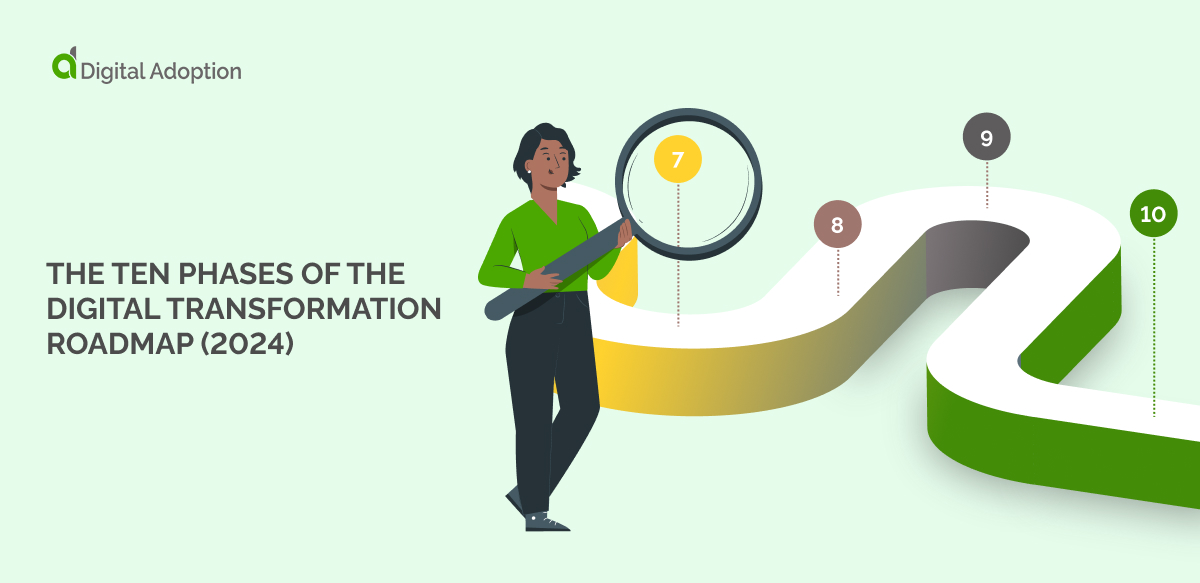- What Is A Digital Transformation Roadmap?
- The 10 Phases Of A Digital Transformation Roadmap.
- Secure CEO and Leadership Buy-In
- Establish Achievable Goals
- Assess Current Business State
- Build A High-Caliber Launch Team
- Prioritize High-Success Initiatives
- Foster A Pro-Change Culture
- Invest In The Best Software Tools
- Adopt New Technologies
- Incorporate An Agile Operating Model
- Embrace Agility In Your Work Processes
- Guiding Success With A Digital Transformation Roadmap
What Is A Digital Transformation Roadmap?
A digital transformation roadmap outlines the tangible goals and strategic actions guiding an organization’s transition towards digital proficiency.
Businesses need to understand the strategic steps necessary for building digital capabilities that inform where they are now (Point A: pre-transformation) and where they want to be (Point B: post-transformation).
A digital transformation roadmap ensures the nature of transformation, with its many potential applications across organizational areas, stays firmly within set parameters.
This includes concrete plans detailing the objectives and touchpoints included along the roadmap, the timeline of each project, and the resources and time needed to complete them.
It informs all key players on proposed and upcoming changes, reminding them when to take breaks and reflect on progress—reviewing and adjusting their route to success as they travel.
The 10 Phases Of A Digital Transformation Roadmap.
Let’s explore the ten phases of a digital transformation roadmap, each representing a crucial step toward organizational evolution:
Secure CEO and Leadership Buy-In
It is critical to ensure the digital transformation roadmap aligns with the vision of the CEO and leadership team from its very inception—without it, most transformation initiatives are sure to fail.
Securing leadership buy-in requires more than signing contracts and green-lighting projects; it requires a sustained commitment from leaders to drive authentic changes, convey why it’s necessary, and reinforce strategic direction.
It also supports team members in the transformation as leaders provide a clear vision for what the team can achieve while working to sustain performance levels in achieving project completion.
Continuous interaction with stakeholders and team members should be encouraged to obtain feedback that can help further refine your strategy. Remain open to opposing views, resolve conflicts among different parties, and work collaboratively to find an agreeable common ground.
Establish Achievable Goals
Establishing objectives is pivotal in making returns on investment in all digital strategies.
In the 2023 State of Organizations Report, McKinsey advises CEOs to create and communicate a clear change narrative that outlines performance goals and associated cultural behaviors supported by benchmarks and fact-based targets.
Rather than treating them as endpoints, consider your goals and targets for digital transformation as milestones along an ongoing journey. There is a prevalent misconception that such change happens when it’s a continual process driven by customer requirements.
A phased approach will assist you in identifying your goals and breaking down the roadmap into achievable pieces that are more manageable for everyone on your team. It’s easy to forget that establishing these goals is simply one half of the equation. Another feat is ensuring that targets are met and that resistance to change is minimized.
Ensure targets and goals are unambiguous to set expectations in what transformation projects can deliver and to illustrate the scale and scope of oncoming change. This provides a multi-pronged benefit in that standard levels increase among employees, and parameters, for say, expediting process completion time, can be firmly set and adhered to.
Assess Current Business State
Any significant voyage for digital transformations of any size begins by assessing your current business state. McKinsey emphasizes that “completing a comprehensive, fact-based assessment of the business to identify opportunities for improvement” is a crucial step in the transformation process, as it helps to establish realistic expectations of what’s possible.
Consider responding to the following inquiries to get started:
- What are the gaps in your systems?
- Which current processes are successful?
- Where can you improve the success of these processes?
- What changes do you want to achieve with your digital transformation roadmap?
After analyzing your responses, you can easily create a few straightforward steps to bolster the performance of your digital transformation efforts. For example, SWOT analysis is a practical framework that reviews any business or project based on Strengths, Weaknesses, Opportunities, and Threats.
The SWOT method can help define your company’s digital capabilities in greater detail. Additionally, frameworks such as STEEP or STEEPLE are perfect guides for measuring internal and external factors.
The STEEP analysis allows companies to understand better their digital capabilities and the current state of their business. STEEP assesses political, social, economic, environmental, and technological factors, offering insights that surpass those provided through SWOT analysis.
The STEEPLE method takes the capabilities of STEEP and further explores legal and ethical factors that can create issues with compliance. Incorporating this into a digital transformation plan enables the simultaneous enhancement of an organization’s technology and culture.
Build A High-Caliber Launch Team
Human-centered design, which places humans and the value they bring at its core, has quickly become one of the essential user experience (UX) approaches due to its ability to generate a devoted and enthusiastic customer base.
Therefore, any launch team must employ designers who consider their customers’ needs. Many businesses even purchase agencies specializing in this approach to guarantee success.
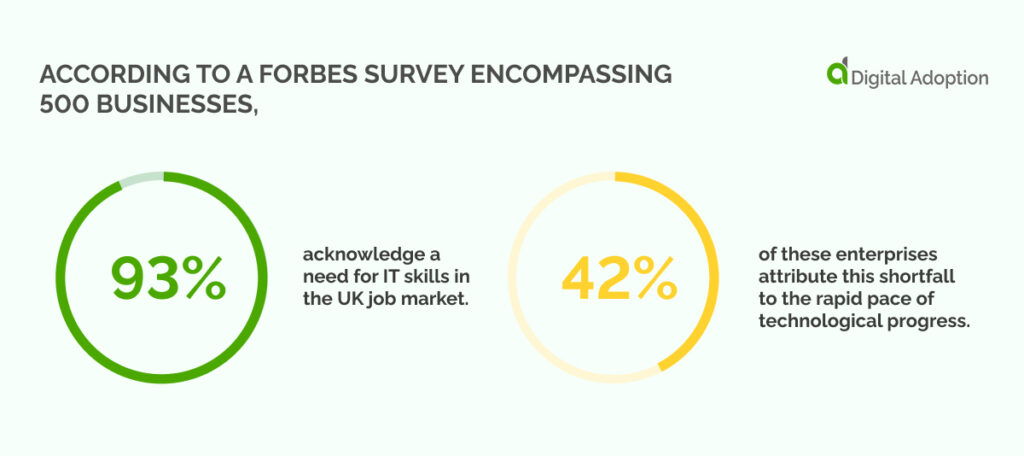
According to a Forbes survey encompassing 500 businesses, 93% acknowledge a need for IT skills in the UK job market. A noteworthy 42% of these enterprises attribute this shortfall to the rapid pace of technological progress.
CIOs and CFOs typically spearhead a digital transformation strategy, but to ensure the success of high-impact digital initiatives, data scientists and scrum masters are equally important. Plus, for you to make any progress, developers must deploy the established roadmap.
This methodology is crucial as it’s not about replacing existing processes with something new – instead, it attempts to incorporate current and new techniques to create greater efficiency than ever before.
Prioritize High-Success Initiatives
Initiating the transformation journey with manageable, swift-to-implement, economic, and key priority projects is an excellent practice.
With external market factors and competitive forces leading to financial fluctuations across firms, transformation efforts can incur prolonged expenses with no fixed end. Emphasizing lighthouse projects initially secures quicker Return on Investment (ROI) and an affirmative reinforcement cycle that supports future projects.
Businesses should support several initiatives that help boost organizational performance and cultivate new opportunities for value creation.
As the transformation advances, this feedback loop generates value and becomes increasingly autonomous, garnering greater support. In other words, start small in the short term but think big for the long term when navigating transitions.
Foster A Pro-Change Culture
For any changes to be successful, ensure that everyone is entirely on board. If you involve team members from the beginning, they will recognize the value of adopting new digital initiatives and technologies.
Demonstrate how these state-of-the-art systems can make their labor easier while minimizing aggravation. When your staff asks questions about modern digital technology and procedures, answer them in detail before problems become too large to overcome.
Invest in innovative technologies that can contribute to the success of your organization and automate mundane tasks. To attain remarkable results, provide teams with the necessary cutting-edge tools, from AI-powered applications to cloud computing platforms that safely store and secure data.
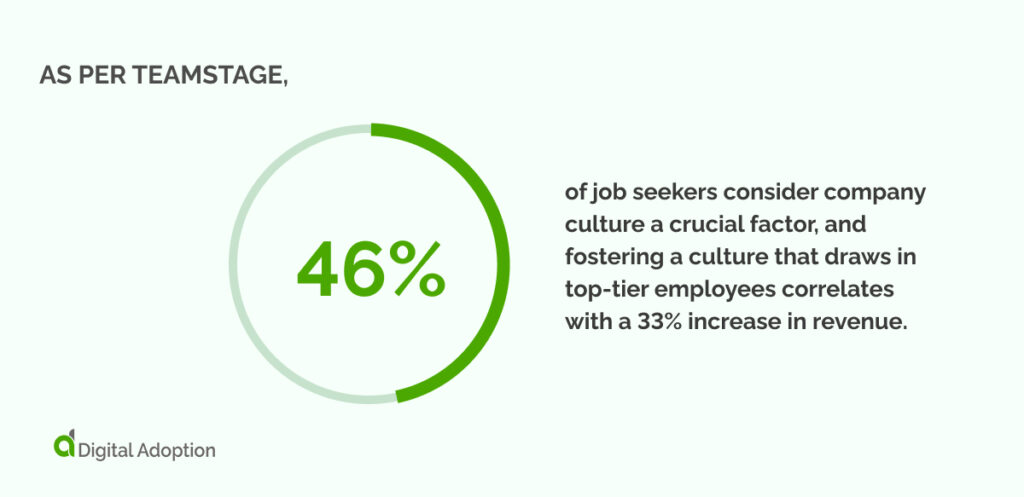
As per Teamstage, 46% of job seekers consider company culture a crucial factor, and fostering a culture that draws in top-tier employees correlates with a 33% increase in revenue.
Invest In The Best Software Tools
Capability building will be necessary for those about to embark on a digital transformation journey, requiring solutions for enhancing workforce skills and systems.
The following list of tools can help enhance performance capabilities and optimize the process from start to finish:
DAPs
Embedding DAPs (digital adoption platforms) with contextual direction can help users reduce onboarding process time and guide them through fundamental processes. Doing so can rapidly increase proficiency and provide helpful feedback details while they navigate the product.
Specialized Feedback Tools
Utilizing specialized feedback tools fosters collaboration and gathers valuable insights to steer digital transformation. An example of such a tool is an integrated collaboration platform, enabling real-time commenting, collaborative document editing, and project-specific feedback channels. This centralized hub streamlines communication, facilitating seamless input from stakeholders and providing data to enhance decision-making in the transformation process.
Training Materials
In crafting digital transformation roadmaps, deploying effective training materials is crucial for expanding employees’ knowledge and skills. Integrating interactive modules, online courses, and workshops ensures a workforce adept at navigating evolving technologies and methodologies, contributing to the overall success of the transformation journey.
Digital Bullet Journals
Digital bullet journals are valuable for crafting a digital transformation roadmap. Team members can use them to track progress and accomplishments through features like task lists and reflective sections. This fosters accountability, provides a collective view of progress, and enhances collaboration for a more cohesive and successful transformation process.
Employee Communication Channels
Employee communication channels create an environment where employees can query, exchange advice, or receive news about their transformation process. These channels provide the perfect platform, whether Slack, MS Teams, or Trello.
Adopt New Technologies
In the digital transformation arena, adopting new technologies occupies a central role. This strategic imperative goes beyond simply responding to industry trends; it is a deliberate and forward-looking choice that reshapes the organization.
Away from improving operational efficiency, tech adoption delves into the core of organizational culture and redefines how teams think, operate, and innovate.
The advent of AI, data analytics, and other technological advancements can become catalysts for organizational growth, propelling enterprises from the traditional realm of doing business into a new frontier for innovation.
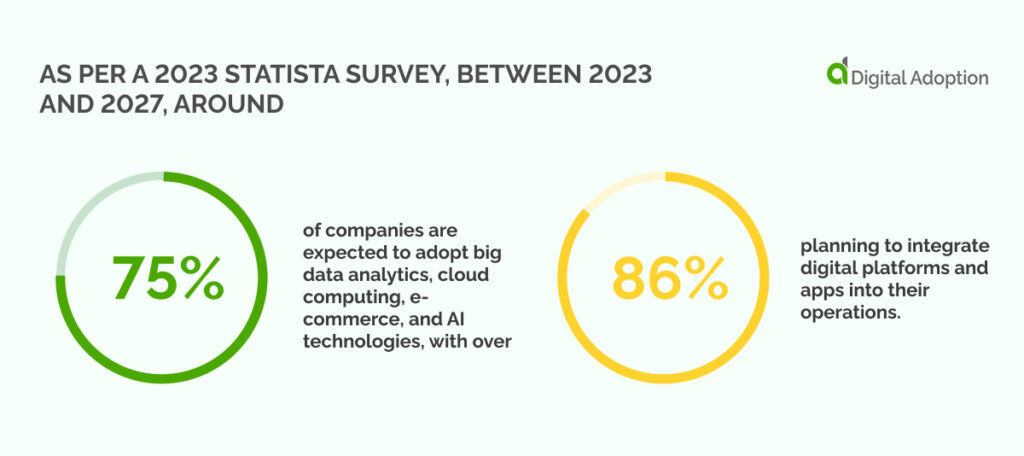
As per a 2023 Statista survey, between 2023 and 2027, around 75% of companies are expected to adopt big data analytics, cloud computing, e-commerce, and AI technologies, with over 86% planning to integrate digital platforms and apps into their operations.
An essential part of a digital transformation roadmap, the adoption of new technology is an exciting and essential component in the transformation journey.
Incorporate An Agile Operating Model
In the contemporary landscape, success hinges on demonstrating flexibility and agility. Organizations must discard outdated operating models unsuitable for succeeding in today’s transformative culture.
The ability to successfully embrace and navigate sudden changes has long been hindered by the rigidity of pre-existing business models that are insular.
The new tactic is honing in on various business verticals and efficiently assembling and dismantling the teams necessary for capturing value in these areas.
Instead of deploying blanket strategies across siloed structures, cultivating an agile operating model tailors strategies to specific units, fostering adaptability and efficiency within each unique organizational component.
Embrace Agility In Your Work Processes
Adopting agile methodologies, organization-wide can fast-track the digital transformation journey, constituting a vital step in the strategic roadmap.
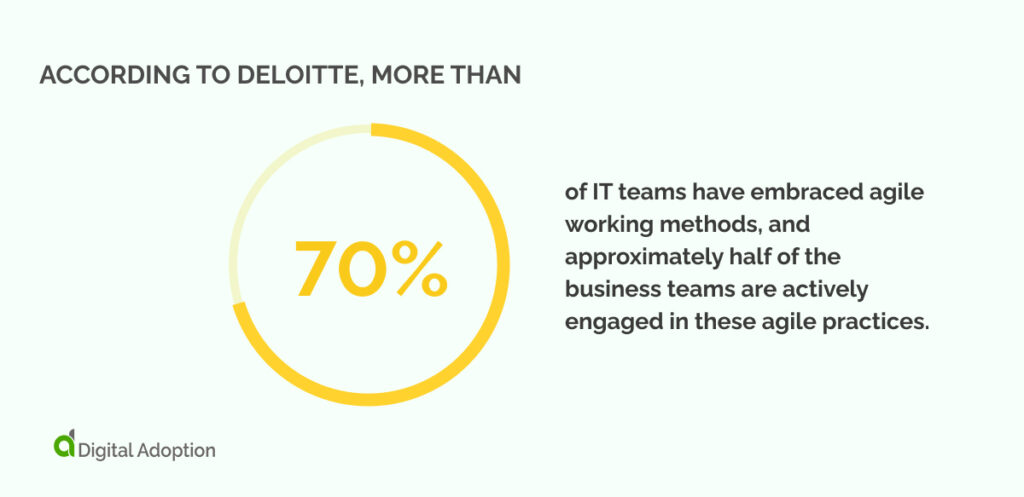
According to Deloitte, more than 70 percent of IT teams have embraced agile working methods, and approximately half of the business teams are actively engaged in these agile practices.
Agile ways of working inject flexibility and responsiveness into every facet of operations. Fostering cross-functional collaboration, breaking down silos, and promoting iterative development cultivates an environment conducive to sudden changes in organizations.
This agile mindset is not only confined to software development or operational modeling; it permeates people, processes, decision-making, and organizational culture.
Agility aligns seamlessly with the dynamic nature of digital transformation, allowing businesses to pivot swiftly in response to shifting tech trends. It accelerates time-to-market for innovations, enhances customer satisfaction through continuous feedback loops, and minimizes the risks associated with large-scale transformations.
Adopting agile practices is the cornerstone of a resilient and adaptive organizational structure, ensuring businesses navigate the complexities of digital evolution with mutability.
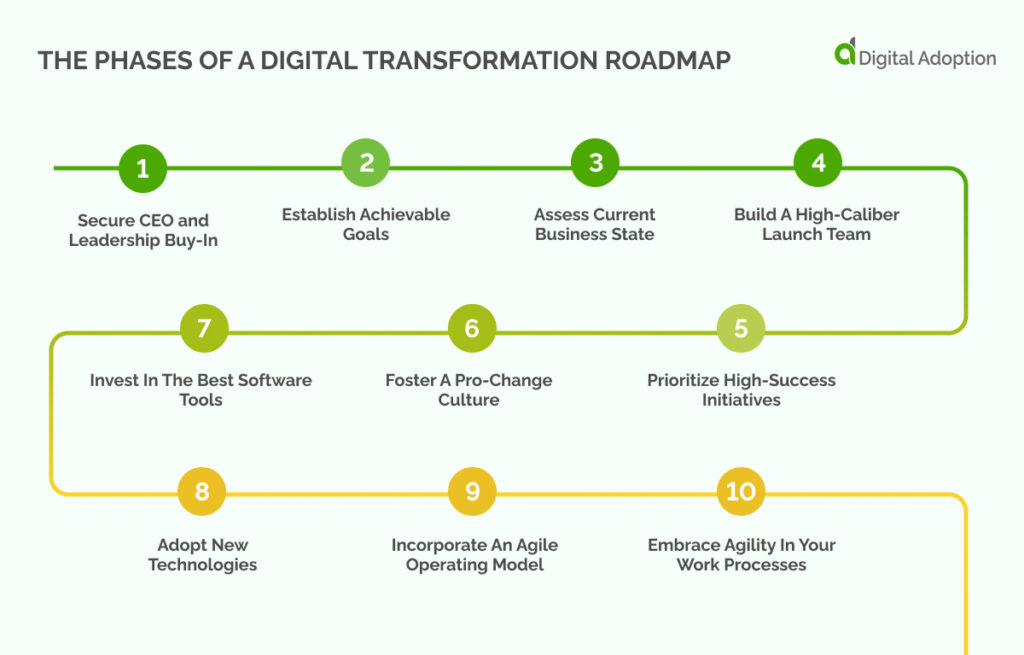
Guiding Success With A Digital Transformation Roadmap
With change being the only constant, there is no better time to start reimagining digital transformation.
Digital transformation roadmaps, armed with a comprehensive understanding of the required intricacies, serve as strategic blueprints, helping organizations better anticipate varying factors, i.e., technological impacts and market fluctuations.
The path forward presents ample opportunities for gaining strategic advantage, and organizations can leverage the insights derived from real-time data analytics to continually refine and optimize their digital strategies.
According to Infosys, CIOs allocate 72% of their budgets to address existing IT needs on average, leaving only 28% for new initiatives and innovation.
Organizations equipped with a well-crafted digital transformation roadmap will be better positioned to adapt and pioneer radical changes in their industries as the digital terrain shifts. The iterative development approach, seamlessly integrated into the transformation roadmap, becomes a perpetual engine for innovation, steering organizations toward sustained success.
Remember, a digital transformation roadmap can serve as a compass for future-ready firms and remains indispensable for those daring to lead in the digital age.

